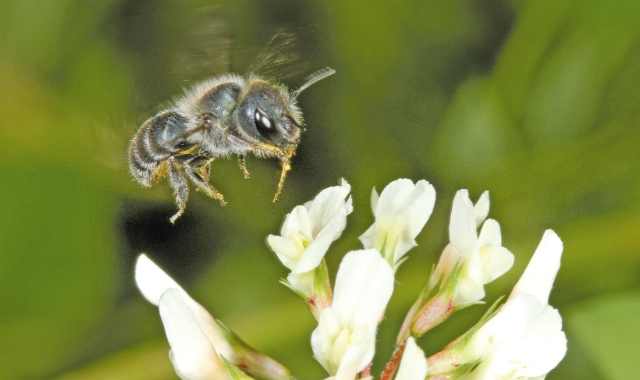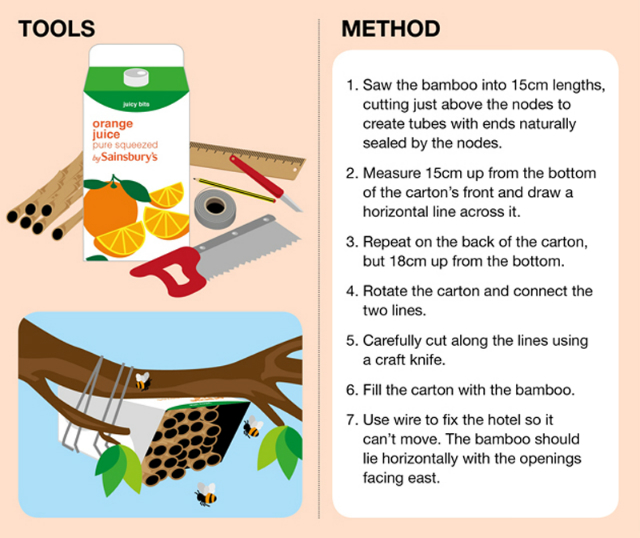LONDON, 2015-4-14 — /EPR Retail News/ — The sun is out, wildlife is waking up and to celebrate National Gardening Week we’ve pulled together some top bee tips to get your garden in shape for bee-autiful visitors.
1. Build a bee hotel
Building a bee hotel couldn’t bee easier using this simple guide
2. Or…. Buy a Bee Hotel
If you’re not the creative type but you’re still keen to create some vacancies buying a bee hotel is a great alternative.
A top tip when buying or building a bee hotel is to check that the tubes are all 10mm or less to make sure it’s suitable for your guests- generally UK bees won’t house themselves in anything with tubes over 10mm.
3. Locate your bee hotel
Remember to locate you bee hotel in an area which faces south and with clear access to the openings.
Make sure your bee hotel is against something like a wall or a fence. Don’t hang your bee hotel using rope or string where it may be able to swing or rotate.
4. Plant a Bee Café
To really create the ultimate b&b accommodation a bee café is a must have. A bee café is essentially an area of plants which are high nectar and pollen yielding, these can be in pots, in the ground or hanging baskets.
Great plants to include in your café are:
- Aromatic herbs such as lavender, thyme, rosemary and sage
- Chives and other alliums
- Poppy, crocus, cornflower, borage, alkanet, viper’s bugloss and bird’s foot trefoil
- Knapweed, phacelia and various types of clover.
For more on seasonal plants which are ‘Perfect for Pollinators’ check out the RHS wesbite
When planting your café try to keep your plants close together in groups- this makes it easier for bee’s to spot and helps conserve their energy as they can collect lots of nectar and pollen (and pollinate) a number plants in one place.
5. Recreate your lawn
Replacing your lawn with a grass free flower mix can be a great way to help the wildlife in your garden. Research conducted by Reading University has indicated that grass free lawns can support up to ten times as many visits from twice as many pollinator species as wildflower turf.
Garden maintenance is also reduced as mowing is cut by up to two thirds- perfect!
For more information on grass free lawns and the research behind it please visit: www.grassfreelawns.co.uk
6. Or… Mow your lawn sparingly
Ideally mow you lawn less often and remove the cuttings in order to allow plants to flower for the longest period and provide the most pollination opportunities.
7. Plant a Wildlife Hedgerow
Planting a hedgerow will really help give you the ‘edge’ in your bee garden. A flowering hedgerow in particular serves a dual purpose in giving you garden privacy as well as providing pollen and nectar for your buzzin’ friends.
For more information on which shrubs to plant in your hedgerows check out this great website: www.buzzaboutbees.net/plants-to-attract-bees
8. Monitor use of chemical herbicides and pesticides
Chemical herbicides and pesticides could have a significant impact on beneficial insects in your garden. Apply only as a last resort, and use strictly in accordance with the label instructions. If you do need to use any of these products, check for Bee Friendly on the label.
9. Identify your visitors
Identifying the species of bees in your garden is a great idea- not only is it interesting to know the species you’re giving homes to but supplying the data to projects such as The Bees, Wasps and Ants Recording Society will provide them will valuable data on bee populations. BWARS members are also great at helping you to identify your buzzy little friends.
Robin Dean is a bee expert and Sainsbury’s beekeeper. He maintains Sainsbury’s bee hotels across the country and looks to help the supermarket boost the dwindling numbers of solitary bees in the UK.
###

